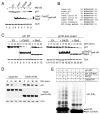APC/C(Cdc20) controls the ubiquitin-mediated degradation of p21 in prometaphase
- PMID: 17679094
- PMCID: PMC2000825
- DOI: 10.1016/j.molcel.2007.06.013
APC/C(Cdc20) controls the ubiquitin-mediated degradation of p21 in prometaphase
Abstract
During the G1/S transition, p21 proteolysis is mediated by Skp2; however, p21 reaccumulates in G2 and is degraded again in prometaphase. How p21 degradation is controlled in mitosis remains unexplored. We found that Cdc20 (an activator of the ubiquitin ligase APC/C) binds p21 in cultured cells and identified a D box motif in p21 necessary for APC/C(Cdc20)-mediated ubiquitylation of p21. Overexpression of Cdc20 or Skp2 destabilized wild-type p21; however, only Skp2, but not Cdc20, was able to destabilize a p21(D box) mutant. Silencing of Cdc20 induced an accumulation of p21, increased the fraction of p21 bound to Cdk1, and inhibited Cdk1 activity in p21(+/+) prometaphase cells, but not in p21(-/-) cells. Thus, in prometaphase Cdc20 positively regulates Cdk1 by mediating the degradation of p21. We propose that the APC/C(Cdc20)-mediated degradation of p21 contributes to the full activation of Cdk1 necessary for mitotic events and prevents mitotic slippage during spindle checkpoint activation.
Figures







Similar articles
-
The APC/C recruits cyclin B1-Cdk1-Cks in prometaphase before D box recognition to control mitotic exit.J Cell Biol. 2010 Aug 23;190(4):587-602. doi: 10.1083/jcb.200912084. J Cell Biol. 2010. PMID: 20733055 Free PMC article.
-
Mechanisms controlling the temporal degradation of Nek2A and Kif18A by the APC/C-Cdc20 complex.EMBO J. 2013 Jan 23;32(2):303-14. doi: 10.1038/emboj.2012.335. Epub 2013 Jan 4. EMBO J. 2013. PMID: 23288039 Free PMC article.
-
Cdc20 proteolysis requires p38 MAPK signaling and Cdh1-independent APC/C ubiquitination during spindle assembly checkpoint activation by cadmium.J Cell Physiol. 2010 May;223(2):327-34. doi: 10.1002/jcp.22038. J Cell Physiol. 2010. PMID: 20054826
-
To cell cycle, swing the APC/C.Biochim Biophys Acta. 2008 Sep;1786(1):49-59. doi: 10.1016/j.bbcan.2008.05.002. Epub 2008 May 21. Biochim Biophys Acta. 2008. PMID: 18544349 Review.
-
Cyclin A and Nek2A: APC/C-Cdc20 substrates invisible to the mitotic spindle checkpoint.Biochem Soc Trans. 2010 Feb;38(Pt 1):72-7. doi: 10.1042/BST0380072. Biochem Soc Trans. 2010. PMID: 20074038 Review.
Cited by
-
Targeting Cdc20 as a novel cancer therapeutic strategy.Pharmacol Ther. 2015 Jul;151:141-51. doi: 10.1016/j.pharmthera.2015.04.002. Epub 2015 Apr 4. Pharmacol Ther. 2015. PMID: 25850036 Free PMC article. Review.
-
RNF115/BCA2 E3 ubiquitin ligase promotes breast cancer cell proliferation through targeting p21Waf1/Cip1 for ubiquitin-mediated degradation.Neoplasia. 2013 Sep;15(9):1028-35. doi: 10.1593/neo.13678. Neoplasia. 2013. PMID: 24027428 Free PMC article.
-
The CRL4Cdt2 ubiquitin ligase targets the degradation of p21Cip1 to control replication licensing.Genes Dev. 2008 Sep 15;22(18):2507-19. doi: 10.1101/gad.1703708. Genes Dev. 2008. PMID: 18794348 Free PMC article.
-
Network mechanisms and dysfunction within an integrated computational model of progression through mitosis in the human cell cycle.PLoS Comput Biol. 2020 Apr 6;16(4):e1007733. doi: 10.1371/journal.pcbi.1007733. eCollection 2020 Apr. PLoS Comput Biol. 2020. PMID: 32251461 Free PMC article.
-
Elevated expression of ΔNp63 in advanced esophageal squamous cell carcinoma.Cancer Sci. 2017 Nov;108(11):2149-2155. doi: 10.1111/cas.13394. Epub 2017 Oct 3. Cancer Sci. 2017. PMID: 28892579 Free PMC article.
References
-
- Acquaviva C, Pines J. The anaphase-promoting complex/cyclosome: APC/C. J Cell Sci. 2006;119:2401–2404. - PubMed
-
- Bashir T, Dorrello NV, Amador V, Guardavaccaro D, Pagano M. Control of the SCF(Skp2-Cks1) ubiquitin ligase by the APC/C(Cdh1) ubiquitin ligase. Nature. 2004;428:190–193. - PubMed
-
- Bates S, Ryan KM, Phillips AC, Vousden KH. Cell cycle arrest and DNA endoreduplication following p21Waf1/Cip1 expression. Oncogene. 1998;17:1691–1703. - PubMed
-
- Bloom J, Amador V, Bartolini F, DeMartino G, Pagano M. Proteasome-Mediated Degradation of p21 via N-Terminal Ubiquitinylation. Cell. 2003;115:71–82. - PubMed
-
- Bloom J, Pagano M. To be or not to be ubiquitinated? Cell Cycle. 2004;3:138–140. - PubMed
Publication types
MeSH terms
Substances
Grants and funding
LinkOut - more resources
Full Text Sources
Other Literature Sources
Molecular Biology Databases
Miscellaneous

